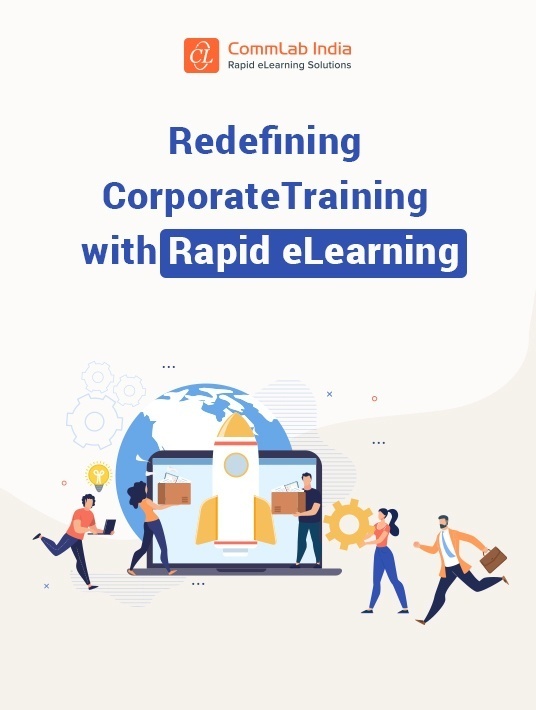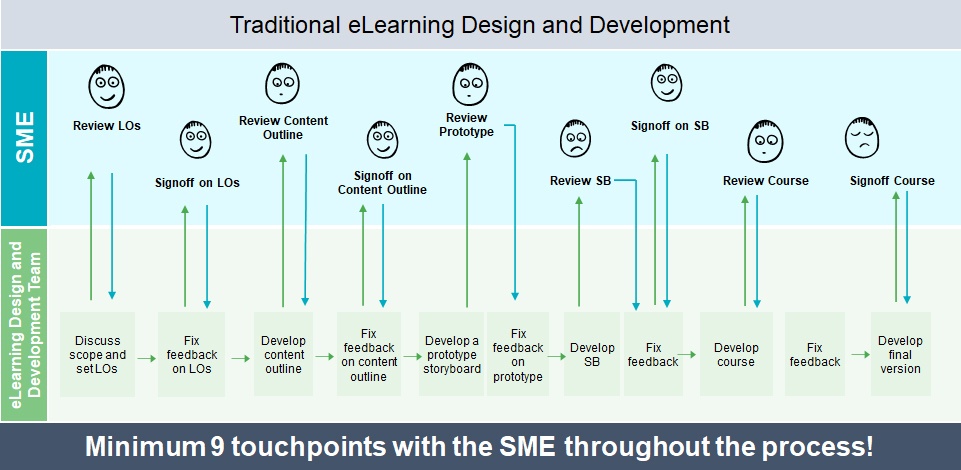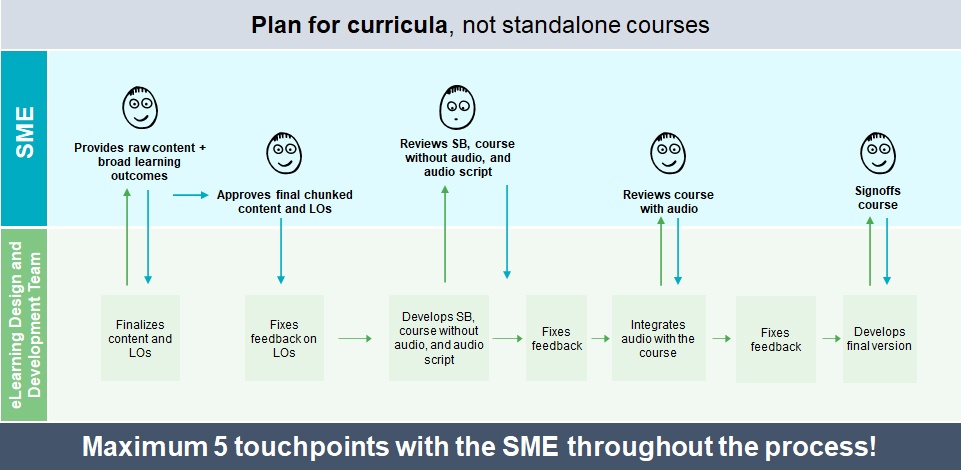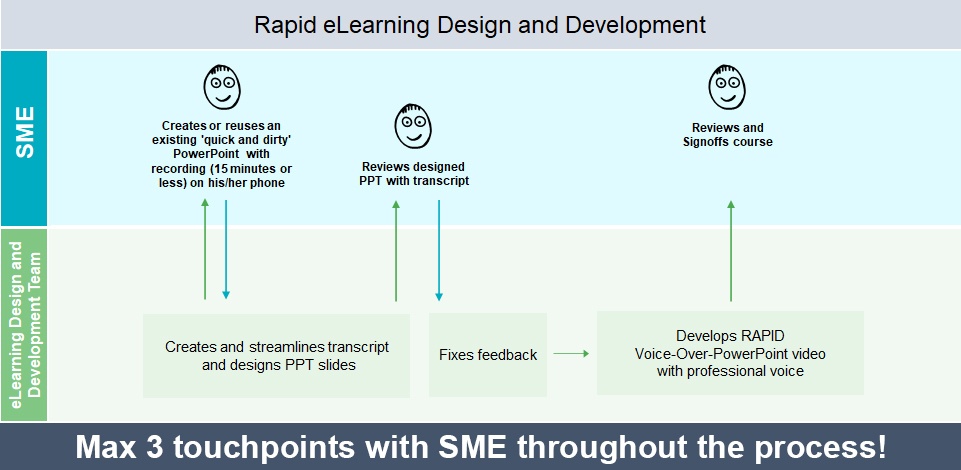A Feather In Rapid eLearning’s Cap—Save SME Time
Can we deliver high-quality courses when the SMEs (Subject Matter Experts) are unwilling or unable to take enough time out to provide their inputs and expertise? How can we induce SMEs to take time out from their busy schedules to provide guidance and know-how during the development of eLearning courses [1]?

There’s a simple solution; cut down the SME time!
Are SME Time Requirements For Traditional eLearning And Rapid eLearning Different?
Is that even possible? Yes, it is possible to cut down SME time with rapid eLearning [2]. But first, let’s look at the SMEs’ profile and why it’s necessary to save their time and involvement in eLearning development.
Is It Really Necessary To Save SME Time?
SMEs are essential for eLearning development because they are the experts on the subject, having access to proprietary information. They are also:
- High-value professionals
- Not primarily involved in training
- Usually traveling or otherwise very busy
Because of these reasons, they hardly have any time to spend on training. They find time only when they are in hotel rooms or over the weekends. But SME inputs are required to finalize the content for eLearning and for reviews at various stages of development.
Traditional eLearning Development
The conventional method of eLearning development requires a lot of SME time. Let’s have a look at the number of times the SME is needed in traditional eLearning development (SME touchpoints).

How can we cut down these touchpoints?
Plan For A Curriculum
Planning for curricula instead of standalone courses will let you save a lot of SME time. Though this option requires more time from the SME at the beginning of the process, it cuts down their time during the rest of the process. With curricula, the SME is needed only 5 times.

Rapid eLearning can substantially decrease the number of touchpoints further.
Rapid eLearning Development
Rapid eLearning is possible only when there is existing content from the classroom or digital learning resources such as legacy Flash courses. Here, SMEs are needed to [3]:
- Approve the learning objectives
- Clarify doubts from the Instructional Design team
- Review and sign off on the storyboard and course
SMEs, whether or not they are involved in training, have PPT decks on their subjects. These can be used as the primary content for the course. But since SMEs do not have time to provide detailed explanations for the PPT slides, they can record the explanation—or even a webinar recording of the SME—and send them along with the PPTs to the development team.
Through these voice recordings, SMEs can add to the PPT with their anecdotal knowledge, best practices, and tips and tricks. When this recording is received by the development team, it can be transcribed and cleaned up to become the audio-script for the course.
This process doesn’t require more than 3 touchpoints with the SME.

This creates a win-win solution for everyone—SMEs, training managers, learners, and the business at large.
When Is The Right Time For Rapid eLearning Development?
If you’re not sure of when you should be going for rapid eLearning, here’s a checklist for you. Rapid eLearning development is the right choice for your organization when:
- Content changes quickly and has a short shelf-life
- Quick turnaround time is required
- There is a time or cost crunch
- A quick blend of classroom training with digital learning is needed [4]
In case of any of the above requirements, it’s time to go rapid, which allows you to save SME time.
3 Pro Tips To Save SME Time With Rapid eLearning
Here are some other tips on saving the SME time with rapid eLearning.
1. Involve SMEs Right From The Start
When the SME doesn’t get involved at the start, this can create a lot of issues. It is better to clarify the SME’s expectations right at the beginning so that everyone involved is on the same page. This, obviously, will result in less feedback from the SME, and so, less rework from the team. Here’s what you need to do.
- Prepare your project plan keeping in mind SME availability.
- Set clear timelines for course reviews and clarification of doubts.
- Establish clear expectations to keep the meetings short.
2. Make It Easy For Them To Share Their Inputs
Not every SME is comfortable with all types of communication. Some might prefer sharing their inputs through face-to-face interactions, some over emails, and some over a phone call. Since most of them do not have the time to meet the IDs in person, you need to understand their preferred method of communication and plan accordingly. Also, keep in mind the amount of time one can save by asking them the right questions.
3. Use Online Review Tools
The use of rapid authoring tools has one great advantage for SMEs—online review. Online collaboration tools such as Lectora ReviewLink and Articulate Storyline Review are cloud-based and make the review process easy and manageable [5]. They make it easy to track and collate feedback, instead of SMEs trying to share their feedback through screenshots of the course.
You can be assured of high-quality courses with rapid eLearning. Coordination between SMEs and Instructional Designers becomes very simple, saving SME time and helping deliver effective training. Download the eBook Redefining Corporate Training With Rapid eLearning and join the webinar to get the chance to incorporate modern learning strategies into your training quickly and easily.
References:
[1] 3 Simple Tips for Designing Learner-Centric E-learning Courses
[2] Rapid eLearning: The Secret to Evolving @ Speed of Business
[3] Subject Matter Experts vs. Instructional Designers: Which Is Better?
[4] Implementing Blended Learning? Be Prepared for These 3 Challenges!
[5] Lectora Online: What Makes this eLearning Authoring Tool an Attractive Investment?









